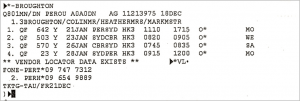SITTTSL006 – Prepare quotations
In this unit of study you will learn to;
- Calculate costs of products and services
- Provide quotations to customer
- Update and record quotations
Introduction
As a tourism professional, you need to become expert at planning and putting together quotations for customers. A quotation (quote) is an itemized list of products and services, under consideration of purchase, and their costs. In preparing a quote you need to make the most efficient and functional use of the customer’s time and money when putting together an itinerary for them.
An itinerary might simply include travel from point A to point B, or it could involve a whole range of services such as overseas flights, accommodation, car hire, sightseeing tours, cruises – all in the same trip!
In order to accurately calculate costs and quote efficiently you need to consider a number of things including (but not limited to):
- When/what date do they want to travel?
- What places do they want to visit?
- Do they have any particular interests?
- How long will they want to spend in each place?
- Do they need accommodation in any or all of these places?
- How do they want to get around – will they need a car or will they go by coach or rail?
- Do they want to do escorted tours?
- How many people are going?
- What age groups?
- Have they travelled before?
- Do they have any airline club memberships?
- Do they require special meals or any other type of special assistance?
- What taxes are applicable?
In addition to this, you will also need to have an understanding of information specific to your industry sector and organisation. For example;
- what quotation systems and procedures do they use? These may be computer based such as CRS/GDS or they may rely on manuals and brochures.
- features and benefits of the products and services you sell so that you can point out the advantages and disadvantages of each.
- sources of costing information for products, services and fees
- any special negotiated cost of supply, contractual arrangements and preferred supplier arrangements that your organisation may have
- commission and mark-up rates and procedures that your organisation uses
- formats for and inclusions of quotations presented to customers, and how to present them in a professional manner.
Calculate costs of products and services.
Tourism products and services can be complex and very expensive. As mentioned in the introduction a customer’s requirements can be very simple; a trip from A to B, but could also involve a number of different operators. In order to keep track of these many components detailed records are necessary including accurate costing information.
Create records to administer customer details and requirements.
Before you can begin to calculate costs for a customer’s travel arrangements you will, first, need to have an idea of their requirements. These will need to be recorded in some format so that no mistakes are made with bookings and costings, and that any alterations made are noted to ensure costs remain correct and all people concerned with the arrangements are working with the most up to date information.
Today, most travel professionals record customer information in computer reservation systems (CRS) such as Galileo/Travelport or Amadeus. These systems will often provide a number of different viewing and working options which influence the way in which information is displayed.
For example, the image shown below is from a standard, formal Galileo/Travelport display. It shows the flight details for Mr, Mrs and Master Broughton. Including their flight numbers, route, times of departure and arrival as well as their telephone numbers and the deadline for issuing their air tickets (among other things). You will learn how to read and use such systems in a different unit of study.

The image on the next page is also from a CRS but is shown in a more user friendly manner, using less industry codes and jargon. It displays the cruise booking details for a passenger and gives the option to view further details such as commission levels, detailed itinerary. It would also give access to customer details such as names, addresses, phone numbers, email, frequent flyer membership details and so on.
…continued in learner guide….
